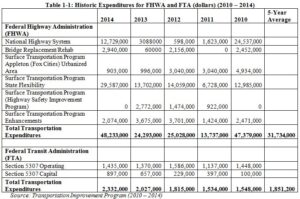Serving Calumet, Fond du Lac, Menominee, Outagamie, Shawano, Waupaca, and Winnebago counties.
Transit Element
- How is transit demand analyzed and forecast for the transportation plan?
Based on user and stakeholder surveys and transit model analysis.
- Transit demand is analyzed through data collected from demographic/rider surveys and boarding and alighting counts. The data is used to calibrate the transit component of the Northeast Travel Demand Model (TDM) which is used to forecast ridership and to test alternative routes. The results from the TDM help develop recommendations for Valley Transit’s Transit Development Plan and Metropolitan Transportation Plan.
- What transit capital investment needs are identified in the plan?
Transit System Recommendations
- Reduce route lengths where boarding and alighting counts are low to nonexistent – decrease residential service and increase arterial service.
- Eliminate areas of duplicated service between Call-A-Ride/Dial-A-Ride/Connector.
- Extend peak hour service in the afternoons/increase frequency.
- Reduce travel and transfer times.
- Cover more area instead of backtracking on routes.
- Review and adjust routes more frequently than annually.
- Flexible routes that can be adjusted based on bad weather/traffic/etc.
- Initiate discussions with Green Bay Metro on examining intercity bus transportation.
- Service to Fox Cities Stadium for games.
- Renew discussions with Combined Locks for service.
- Make a connection to the VA Milwaukee shuttle in the morning.
- Examine ways to incorporate service requests into service areas without major changes:
- Affinity Pediatrics in Neenah
- Intersection of Racine Street and Midway Road
- Evergreen Drive and Ballard Road Medical offices/Park and Ride
- Railroad Street and Kimberly Avenue in Kimberly
- Later service to Wal-Mart in Neenah
- Park and Ride lot in Greenville
- Indoor Skate Park in Kimberly
- Time Warner Cable on Plank Road
Passes and fares
- A student bus pass program (K – 12/universities/technical colleges).
- Expand the number of outlets where tickets can be purchased.
- Examine online ticket printing.
- A frequent user discounts/rewards program/daily specials.
Information and technology
- The use of color coded signage along the routes to match up with route maps.
- Use reflective tape on signage so it is more visible at night.
- Continue to utilize the transit model maintained by the East Central Wisconsin Regional Planning Commission.
- Include minor civil division (MCD) boundaries on all routes maps and riders guides.
- Coordinated expansion of the Bus Buddy Program with Making the Ride Happen to include all age groups.
- Expansion of Intelligent Transportation Systems (ITS) such as:
- Global positioning systems (GPS) on buses.
- Cell phone technology with real-time updates (GPS is needed on the buses).
- Message boards at the transit center with important real time information.
- Wireless internet on buses.
- Audio/visual entertainment on buses.
Planning and policy
- Further examination and implementation of a regional transit authority (RTA) pending statewide enabling legislation.
- Expanded involvement in land use planning and development efforts to curb sprawl and facilitate transit oriented development patterns, but continue to maintain extensive service in downtown Appleton and other central business districts where the densities are higher.
- Continue to participate in security/evacuation plans.
Marketing and Education
- Target potential teen users that choose not to get a driver’s license due to increasing costs of vehicle operation and maintenance.
- Invest/market more heavily in the notion that Valley Transit is an affordable alternative to commuting.
- Invest/market more heavily to a vast market of residents not aware of Valley Transit.
- Continue to pursue feasible marketing partnerships with other agencies and organizations.
- Expand discussions with major employers to subsidize transit cost for employees.
- Participation in area Health and Wellness Fairs.
Funding
- Continued pursuit of other nontraditional funding opportunities both public and private, for both operation and capital improvements.
- Further examine the staffing of a mobility manager
Image
- Continue to enhance the public image/perception of the Appleton Transit Center.
- Enhance the public image/perception of public transportation throughout the region by expanding education and outreach efforts particularly to groups not aware of Valley Transit. Future marketing efforts should also focus on the notion that the bus system is alternative to commuting by vehicle.
- Increase staffing presence at the Appleton Transit Center (staff, community leaders, police, etc.).
- Reexamine the Carry-on Policy to have more flexibility for the consumer.
- How is transit revenue forecast for the plan?
Federal Highway Administration (FHWA) and Federal Transit Administration (FTA) Expenditures/Revenues
The estimated long range financial need for FHWA and FTA TMA expenditures was calculated using the following steps:
- Gathered federal expenditures from the TMA’s TIP (2010-2014) provided by ECWRPC. Please reference Table 1-1.

- To account for a degree of variation in local federal transportation spending projects in a given year by FHWA and FTA, a 5-year average value of total local expenditures was calculated. These 5-year average values were used to derive the total average amount of FHWA and FTA MPO transportation expenditures.
To account for projected revenues needed over the life of this plan, it was assumed that FHWA and FTA transportation expenditures must at a minimum be the amount of revenue needed to be fiscally constrained (i.e. expenditures should equal revenues). The calculated 5-year average of expenditures was used to estimate expenses for the life of the plan. An inflation factor of 1.0 percent (provided by WisDOT) was applied to the 2010-2014 annual average expenses and compounded for each year out to 2050. This data was then grouped by 5 year increments as shown in Table 1-2.
 Source: Appleton LRTP, Chapter 18, Page 18-10
Source: Appleton LRTP, Chapter 18, Page 18-10
Please be prepared to discuss the following at the site review meeting. A written response is not required.
- What is the state of funding for transit in the region?
- What is the MPO’s role in working with Valley Transit, with regards to service and operation’s needs, and transit visioning for the region?

